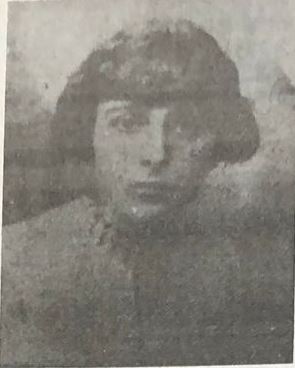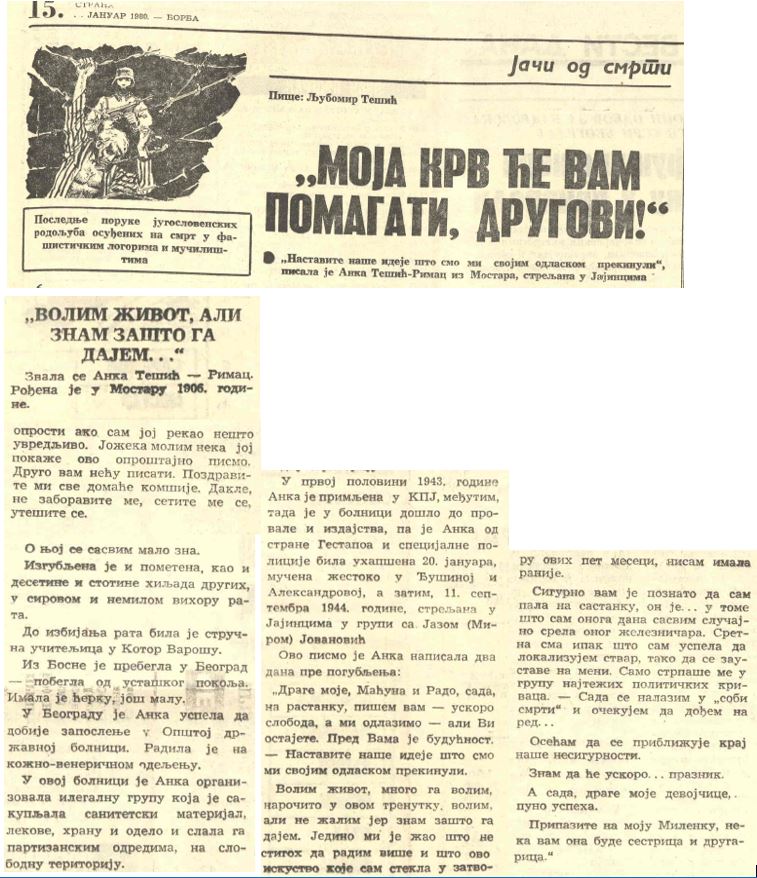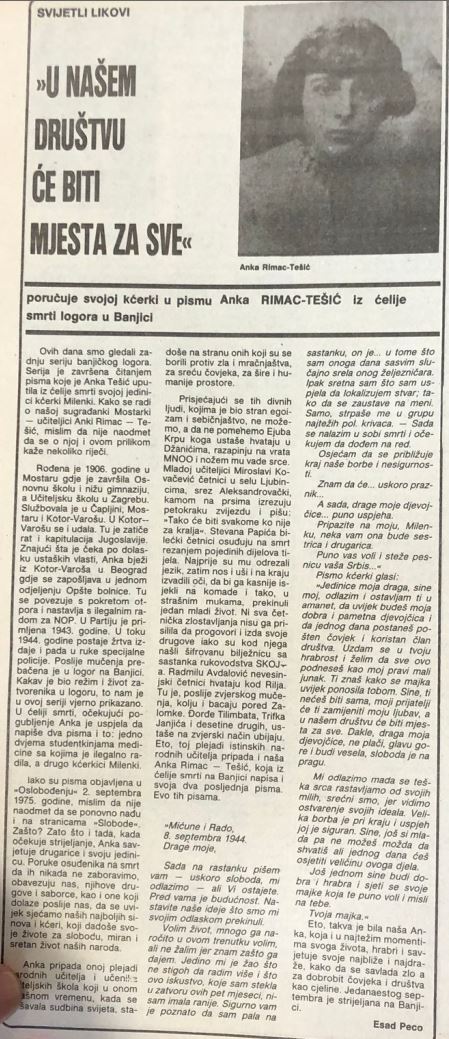
book “Spomenica Mostara 1941-1945.”
Ana M. TEŠIĆ
ANA ANKA TEŠIĆ, daughter of ANTE, born on December 27, 1906, in Mostar. She was a teacher who served in Čapljina, Mostar, and Kotor-Varoš, and lived in Belgrade from 1941. She became a member of the Communist Party of Yugoslavia (KPJ) in 1943. She was arrested by the Germans in early 1944 in Belgrade and killed later that year in the Banjica concentration camp along with a group of 26 other women.
While she was on death row, Anka wrote two letters, one of them for her daughter Milenka: “My dear only child, my dear, I am leaving and I leave it to you, that you will be my good and smart little girl and that one day you will become an honest person and a useful member of society. I trust in your courage and I want you to bear all this as my true little hero. You know how proud your mother was always of you. Daughter, you will not be alone, my friends will replace my love for you, and in our society there will be room for everyone. So, my dear girl, don’t cry, keep your head up and be cheerful, freedom is on the threshold. We are leaving, although it is with a heavy heart that we part with our loved ones, we are happy, because we see the realization of our ideals. The great struggle is at an end and its success is certain. Child, you are still young so you may not be able to understand, but one day you will feel the greatness of this work. Once again, be good and brave and remember your mother who loves you very much and thinks of you. Your mother”
The last episode of the TV series “Banjica” (1984) ends with the reading of Anka’s letter.
EXCERPT FROM LITERATURE:
“One of the last executions in 1944 belongs to the most significant dates of the Banjica camp, and probably of concentration camps throughout occupied Europe. On September 11 of that year, the last larger group of women, female prisoners of the Special Police, first category from the thirty-eight, was executed in the death chamber for women. It was a time when the final battles for the liberation of Serbia were being prepared (…) According to existing lists, 26 women were called the day before the execution, among them, Anka Pešić*, a professional teacher from Belgrade, born in 1906 in Mostar (…) Although most of these brave women were listed as housewives, they were all seasoned fighters of the Communist Party of Yugoslavia, underground activists, and partisans. Although they came from various parts of Yugoslavia, they were inspired by the same spirit of freedom and united in a common desire to fight with honor. Their names must be recorded. These are names to remember. The feat they performed is a feat for history. When they were tied up in the basement hallway, barefoot, they resisted and attacked Deputy Camp Commander Peter Kruger and police agents and gendarmes. Prior to the roll call, which they were expecting because the liquidation of all first-category culprits was underway, Ankica Jandrijević and Darinka Ruman spoke to their comrades from the neighboring women’s chamber number 37 through the keyhole. They said they had learned that the next day the first-category women would be shot. They did not show any signs of being alarmed. On the contrary, they claimed to be well-prepared for this final act in their lives. The camp chief Vujković rarely resided in the camp by then. His assistant Čarapić received orders to carry out the execution of women classified as first category. He and Kruger came to the thirty-eighth chamber to finish their ‘job.’ When the 26 women were called, a united cry resounded in the room: ‘Long live the Communist Party of Yugoslavia!’ Other slogans and curses from the gendarmes were also heard. They were immediately taken to the hallway for binding. At that moment, they collectively attacked Kruger, Čarapić, and the police agents. They fought back with empty hands while the others had knives. It is not easy to determine today who among them was the most resolute in their resistance. According to scarce gendarme testimonies a day later, some pieces of this heroic mosaic can be assembled. The main initiators of the attack were likely Radmila Rajković, Zora Obradović, Radmila Šnajder, Jelica Letić, Jovanka Bogdanović, Darinka Ruman, and Vidosava Rajković. Some of them brought down Kruger and started to suffocate him. The others, with pieces of the cell doors in their hands, began to beat the police agents and gendarmes. Gunshots and the cries of women stabbed with cold weapons were soon heard. The jailer Radovan Gudelj beat them with an iron lever from the door. He smashed the head of Professor Vida Rajković from Aranđelovac. Several women were killed on the spot, while the rest were beaten and stabbed (…) After the women who had made history were subdued, they were taken to the Jewish cemetery, where those who were still alive were finished off.”
*In the book “Banjica Camp 1941-1944,” Anka’s last name is listed as Pešić.
grupa autora: Spomenica Mostara 1941-1945.; Sima Begović: Logor Banjica 1941–1944 II . Photo: Ana Rimac – from newspaper “Sloboda”, 26.11.1984, Banjički logor – Arhivske fotografije – Holokaust (holocaust.rs) article “Moja krv će vam pomagati drugovi“, “Borba”, 18.1.1980.
Do you have more information about this fighter? Share your stories and photographs. Let's keep the memory alive!



